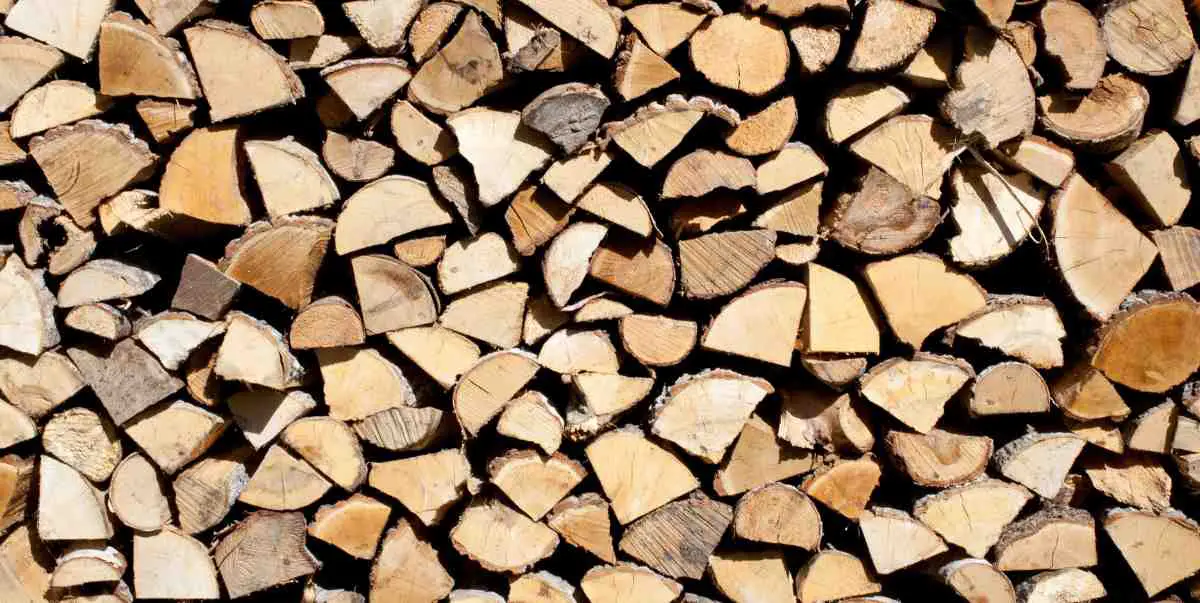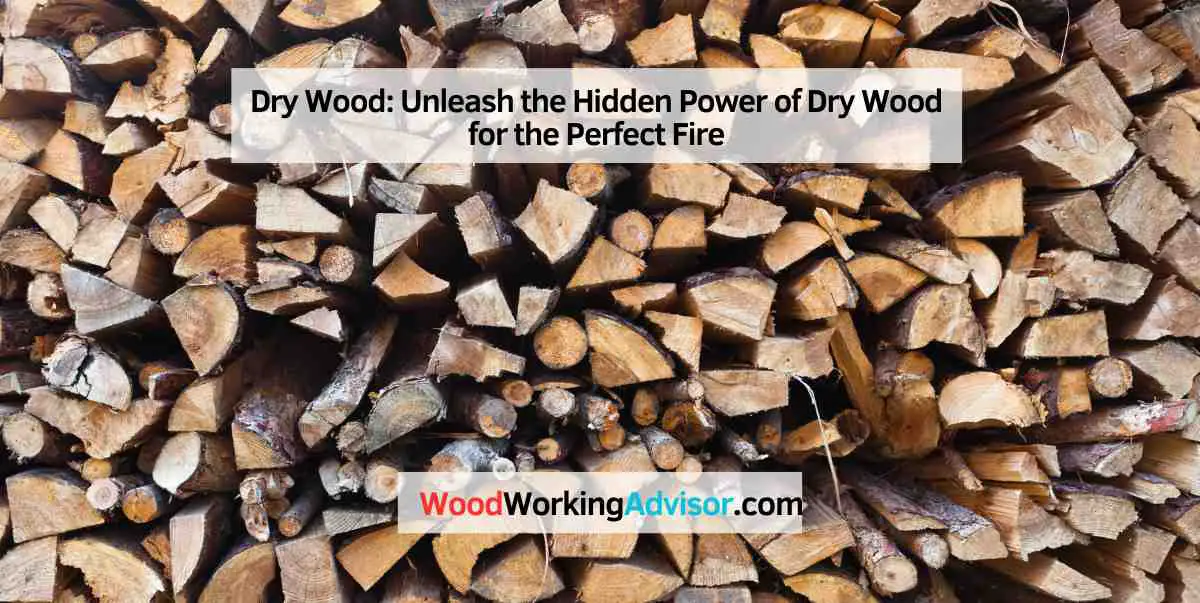Dry wood is wood that has low moisture content, typically below 20%. It is essential for burning efficiently in fireplaces or wood stoves.
Dry wood burns hotter and produces less smoke, making it an ideal choice for heating and cooking. Dry wood is crucial for various purposes, including construction, woodworking, and fuel. When wood has low moisture content, it is less prone to rot and decay, making it suitable for building structures and making furniture.
Additionally, dry wood is preferred for fuel as it burns more efficiently, releasing more heat and less smoke. Understanding the characteristics of dry wood and its uses is important for anyone working with wood materials. We will delve into the importance of dry wood and its various applications in different industries.
Discovering Dry Wood
Dry wood is a crucial element for various activities such as construction, carpentry, and fuel. Understanding the different types of dry wood and their characteristics is key to utilizing them effectively. Let’s delve into the world of dry wood and uncover its diverse nature.
Types Of Dry Wood
Dry wood can be classified into various types based on the trees it comes from. Some of the common types of dry wood include:
- Oak
- Maple
- Walnut
- Pine
Characteristics Of Dry Wood
Recognizing the characteristics of dry wood is essential for choosing the right type for a specific purpose. Here are some key characteristics to consider:
- Density
- Color
- Grain pattern
- Strength

Benefits Of Using Dry Wood
Dry wood offers numerous benefits, including improved efficiency in burning, reduced smoke emission, and a longer lifespan for wood-burning appliances. Additionally, it produces more heat and decreases the risk of creosote buildup in chimneys, making it a smart choice for heating and environmentally conscious individuals.
Dry wood offers several advantages when used for fuel, making it a preferred option for heating and cooking. The benefits of using dry wood include efficient fire starter, cleaner burning, and less smoke production.
Efficient Fire Starter
Dry wood ignites quickly and easily due to its low moisture content. This makes it an efficient choice for starting fires, whether it’s in a fireplace, wood stove, or outdoor fire pit. The absence of excess moisture allows the wood to catch fire faster, producing heat more rapidly.
Cleaner Burning
Dry wood produces a cleaner burn compared to damp or wet wood. With less moisture to burn off, dry wood generates fewer particulates and pollutants, leading to a cleaner combustion process. This results in reduced creosote buildup in chimneys and a lower risk of carbon monoxide emissions.
Less Smoke Production
Using dry wood significantly reduces smoke production during combustion. The absence of excessive moisture prevents smoldering and incomplete combustion, leading to a noticeable decrease in smoke emissions. This not only benefits the environment but also contributes to a more pleasant and healthier indoor and outdoor air quality.
In summary, using dry wood offers the advantages of an efficient fire starter, cleaner burning, and less smoke production, making it a desirable choice for heating and cooking purposes.
Acquiring And Storing Dry Wood
Dry wood is essential for a successful fire, whether you’re using it in a fireplace, wood stove, or campfire. Acquiring and storing dry wood properly is crucial to ensure it burns efficiently and safely. In this section, we will discuss seasoning wood properly and optimal storage techniques to maintain the quality of your firewood.
Seasoning Wood Properly
Seasoning wood involves the process of drying freshly cut wood to reduce its moisture content. This not only helps the wood burn cleaner but also minimizes the risk of creosote buildup in your chimney. The optimal moisture level for firewood is around 20% or lower.
Optimal Storage Techniques
Proper storage is key to preserving the quality of your firewood. Here are some tips to help you store your dry wood effectively:
- Keep the wood elevated off the ground to prevent moisture absorption.
- Stack the wood loosely to promote airflow and faster drying.
- Store the wood in a well-ventilated area to prevent mold and mildew growth.
- Cover the top of the woodpile with a tarp to protect it from rain and snow.
Preparing Dry Wood For Fire
When it comes to starting a fire, one of the most crucial aspects is using dry wood. Wet or damp wood can be difficult to ignite and can create excessive smoke, leading to an inefficient fire. To have a successful and enjoyable fire experience, it is essential to properly prepare the wood, ensuring it is dry and ready to burn.
Cutting And Splitting Techniques
- Choose the right tools for cutting and splitting wood. A sharp axe or a chainsaw with a well-maintained blade will make the job easier and safer.
- Start by cutting the wood into manageable lengths of about 16 to 18 inches. This size is ideal for most fireplaces and wood stoves.
- Remove any branches or twigs from the wood pieces, as they can slow down the drying process and contribute to excessive smoke.
- After cutting, split the wood into smaller pieces to expose more surface area to the air. This will allow the wood to dry faster.
- Use a maul or a splitting wedge to split the wood. Aim for pieces that are around 3 to 6 inches in diameter, as they will dry more quickly and burn efficiently.
Drying Methods
Drying the wood properly is essential to ensure it is ready for the fire. Here are a few effective drying methods:
- Air Drying: One of the most common methods is air drying. Stack the split wood in a well-ventilated area with good airflow. Avoid placing it directly on the ground to prevent moisture absorption.
- Covered Storage: If you have a shed or a covered area, you can stack the wood and cover it with a tarp or a waterproof cover. This method protects the wood from rain or snow while still allowing air circulation.
- Sunlight Exposure: Sunlight can help speed up the drying process. If possible, place the wood in direct sunlight, as it will help evaporate the moisture more quickly.
Remember, the drying time will vary depending on the type of wood and the environmental conditions. Allow the wood to dry for at least six to twelve months before using it for a fire. Dry wood will not only burn more efficiently, but it will also produce less smoke and creosote buildup in your chimney.
Utilizing Dry Wood Safely
When it comes to using dry wood for fires, safety should always be the top priority. By following some fire safety measures and ensuring proper ventilation, you can enjoy the warmth and ambiance of a wood fire without putting yourself or your property at risk.
Fire Safety Measures
To prevent accidents and minimize the chances of a fire getting out of control, there are a few important fire safety measures to keep in mind:
- Keep a fire extinguisher nearby in case of emergency.
- Clear any flammable items or debris from the area around the fireplace or wood stove.
- Use a fireplace screen or protective barrier to prevent sparks from flying out.
- Never leave a fire unattended and make sure it is completely extinguished before leaving the room or going to bed.
Ensuring Proper Ventilation
Proper ventilation is crucial when using dry wood for fires. Without adequate airflow, the fire could produce harmful gases such as carbon monoxide. Here are a few tips to ensure proper ventilation:
- Open the flue or damper before lighting the fire to allow smoke and gases to escape through the chimney.
- Regularly clean and inspect the chimney to remove any buildup or blockages.
- Make sure the room is well-ventilated by opening windows or using a fan to circulate fresh air.
In conclusion, by adhering to fire safety measures and ensuring proper ventilation, you can safely enjoy the warmth and beauty of a fire fueled by dry wood. Remember to remain vigilant and always prioritize safety to prevent accidents and protect yourself and your property.
Enhancing Fire Cooking With Dry Wood
Flavor Impact On Food
Dry wood imparts a distinct smoky flavor to the food cooked over flames.
Maintaining Consistent Heat
Dry wood burns consistently, providing steady heat for optimal cooking results.
Exploring The Aesthetics Of Dry Wood Fires
The crackling sound of dry wood burning evokes warmth and comfort, creating a captivating experience for all who gather around the fire.
Ambiance And Mood Setting
- Dry wood fires infuse the atmosphere with a cozy glow, perfect for intimate gatherings.
- The subtle scent of burning wood contributes to a sense of relaxation and tranquility.
- Embers dancing in the fire add a touch of enchantment, enhancing the overall ambiance.
Visual Appeal
- The flames from dry wood fires create mesmerizing patterns that captivate the eye.
- The warm hues of the fire lend a rustic charm to any setting, enhancing the visual appeal.
- Watching the crackling flames can be a visual treat, offering a calming and meditative experience.
Conclusion And Final Tips
The use of dry wood for your fire experience is crucial for ensuring a clean and efficient burn. In this concluding section, we’ll explore how to ensure sustainable wood sourcing and provide practical tips for optimizing your fire experience.
Ensuring Sustainable Wood Sourcing
It’s important to prioritize sustainable wood sourcing to minimize the environmental impact. When selecting dry wood, look for suppliers who practice responsible forestry management. Ensure that the wood is certified by organizations such as the Forest Stewardship Council (FSC) or the Sustainable Forestry Initiative (SFI).
Practical Tips For Optimal Fire Experience
- Choose hardwoods such as oak, maple, or birch for longer-lasting and cleaner burns.
- Store your dry wood in a well-ventilated area to maintain optimal moisture levels.
- Regularly inspect the wood for signs of decay or insect infestation to ensure high-quality burning.
- Use a moisture meter to verify that the wood has a moisture content of 20% or less for efficient combustion.

Frequently Asked Questions Of Dry Wood
What Are The Benefits Of Using Dry Wood For Cooking?
Dry wood is ideal for cooking as it produces high heat, which helps in faster cooking. It also creates a distinct smoky flavor in the food, enhancing the overall taste. Additionally, dry wood burns cleanly, emitting less smoke and reducing the risk of harmful chemicals being released into the air.
How Long Does It Take For Wood To Dry Naturally?
The time it takes for wood to dry naturally varies depending on various factors such as the type of wood, weather conditions, and the size of the wood pieces. On average, it can take anywhere from 6 months to 2 years for the wood to fully dry.
Proper storage and air circulation can speed up the drying process.
Can I Use Wet Wood For Home Heating?
Using wet wood for home heating is not recommended. Wet wood contains high moisture content, which leads to inefficient combustion, lower heat output, and excessive smoke production. It can also cause increased creosote buildup in the chimney, posing a fire hazard.
Therefore, it is better to use dry or seasoned wood for home heating purposes.
How Can I Tell If The Wood Is Dry Enough For Burning?
To determine if the wood is dry enough for burning, you can perform a simple visual inspection. Dry wood appears lighter in color, has cracks at the ends, and makes a hollow sound when tapped together. You can also use a moisture meter to measure the moisture content of the wood.
A moisture content below 20% is ideal for burning.
Conclusion
In essence, dry wood is essential for various purposes like heating homes, cooking food, and crafting. Understanding its characteristics and uses can enhance our daily lives. By investing in quality dry wood, one can experience the benefits it offers. Make sure to choose the right type for your needs.

